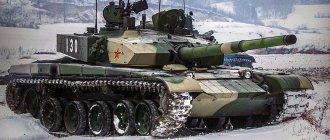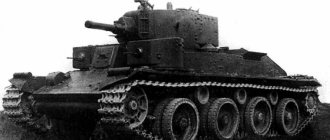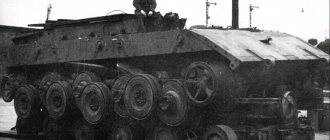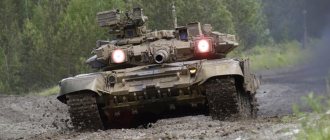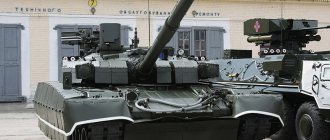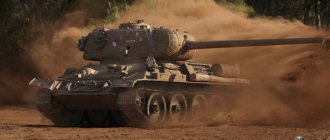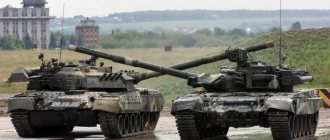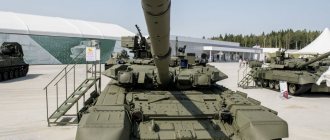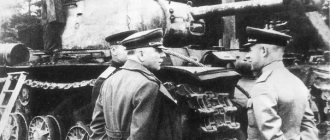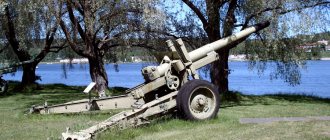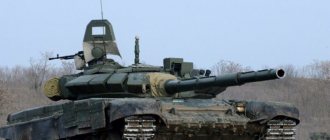The promising Anglo-West German tank MBT-80/Kpz-80, work on which had been underway since 1972, was called upon to replace the Chieftain tanks. The program was canceled in 1977 due to disagreements between tank builders and the militaries of both countries. The question of the British main battle tank of the 80s remains open. In 1978-1979 The development of the national tank MVT-80 was carried out using the groundwork developed within the framework of the Anglo-German program. The problem was finally resolved in the most unexpected way in 1979. when the refusal of the new Iranian government to order Shir-2 tanks added headaches to the British. A large amount of money was pumped into the FV 4030/3 project, time was spent, and seven experimental tanks were built.
After significant hesitation, the British made a compromise decision: to continue the evolutionary development of the FV 4030 project, using the Shir-2 tank as a basis, but to replace only the Chieftains, which are in service with the British Rhine Army, with new tanks. In 1980, a contract was signed for the supply of 225 tanks. To test new solutions and test them, seven Shir-2 prototypes were converted, receiving the new designation FV 4030/4 and their own name “ Challenger ” (“Challenger”). The design of the vehicle was carried out by designers from the Technical Directorate of Military Vehicles and Equipment (MVEE) and specialists from the State Tank Plant. Just like when designing the Chieftain. One of the most critical was the problem of mass. The specification of the General Staff limited the mass of the promising tank to 54.8 tons (the mass of the Chieftain Mk.5 tank), however, even during the development of the MVT-80 project, British experts came to the conclusion that it was impossible to enhance armor protection provided that the mass of the new tank was kept at the level mass of "Chieftain" Mk.5.
The weight had to be increased to 60-62 tons, in this case it became possible to strengthen the armor of the frontal part of the hull and turret, as well as the sides. MVEE engineers, as a justification for the possibility of increasing mass, put forward the thesis that there is an insignificant difference between 50- and 60-ton tanks. So, with equal specific power and ground pressure, mobility, average speed, throttle response and maneuverability will be approximately the same. One of the criteria limiting the mass of a tank is the load capacity of road bridges. The British carried out an analysis of the distribution of engineering structures in the European theater of operations that limit the mobility of tanks; It turned out that most bridges are designed for a load of 20 tons, that is, they will fail with equal success under both a 50-ton tank and a tank weighing 60 tons, and bridges with a load capacity of 50 and 60 tons are “spread” approximately evenly across Europe. As a result of this kind of research and analysis, it was possible to convince the military to raise the upper weight limit to the required 60-62 tons. The tanks were tested at Bovington; During them, seven cars drove more than 100 thousand km. Their maintainability and reliability, as well as the electromagnetic compatibility of radio equipment, were checked. At the final stage in October 1982, the participation of vehicles in four-day continuous combat operations was simulated. The military was satisfied, and in December 1982, the British Army's Challenger tank program manager, Colonel Murray-Brown, signed the test completion certificate.
Serial production began in 1983, with the Royal Hussars being the first to receive the new tanks. Until 1988, 420 Challenger tanks were built. entered service only with the British Army. The tank is designed according to a classic design. The tank's hull is completely welded and made of Chobham combined armor. It lacks the cast parts found in the hull design of the Chieftain tank. The bottom of the hull is V-shaped to reduce the impact of anti-tank mine detonation. At the front of the case there is a control compartment. The driver's seat is located along the axis of the tank: just like on the Chieftain, in the combat position the driver takes a reclining position. The rotation is controlled using the steering wheel. To monitor the terrain, a wide-angle periscope device is used, which can easily be replaced with an infrared non-illuminated night vision device. The fighting compartment and turret occupy the middle part of the tank. The welded turret is equipped with a 120 mm L11A5 rifled gun.
Compared to a similar gun on the Chieftain tank, the Challenger gun has a shorter barrel. The shorter barrel makes it easier to stabilize the gun while moving. The use of new steel in the design of the modernized gun, obtained by electroslag remelting, the maximum pressure in the barrel bore from 610 to 630 MPa (6200 - 6400 kgf/cm2) and, despite the reduced barrel length, the initial velocity of the projectile remained the same. The gun's breech has undergone changes to improve sealing. Ammunition consisting of 64 rounds of separate loading is located in the control compartment and in the fighting compartment. A typical variant is considered to be 34 armor-piercing sub-caliber shells, 15 armor-piercing high-explosive and five smoke shells. The ammunition is stored in armored containers surrounded by a jacket with a special liquid, which reduces the likelihood of fire and detonation of ammunition. All powder charges are located below the turret ring. Gun pointing angles in the vertical plane are from -10° to +20°.
The drives for pointing the gun in the vertical plane and turning the turret are electric, emergency drives are mechanical. The turret rotation speed varies from 0.01 to 24 degrees/s, the gun pointing speed in the vertical plane varies from 0.01 to 6 degrees/s. The gun is stabilized in two planes. To the left of the gun is a 7.62MM L8A2 machine gun, coaxial with a cannon; Ammunition for the machine gun - 4000 rounds. To the right of the gun are the commander's and gunner's workstations, and to the left are the loader's. The fire control system has undergone minor changes compared to the fire control system of the Shir-1 tank. It includes a gunner's sight with an integrated laser rangefinder, an electronic ballistic computer and a gun stabilizer. The ballistic computer generates data for firing, taking into account the range to the target, the angular velocity of the target, the roll angle of the tank's gun trunnions, wind speed, atmospheric pressure and air temperature. The gunner uses a Barr & Strood TLS No. 10 Mk 10x periscope sight as the main sight. 1, which has a built-in laser rangefinder. The laser emitter of the rangefinder uses ytrium-aluminum garnet instead of the ruby used in the rangefinder of the Chieftain tank. Auxiliary sight - telescopic, Vickers Instruments, AFV No. 80 Mk. l with sevenfold magnification.
The sight is adjusted using a collimator and a reflective mirror mounted on the gun barrel near the muzzle. To conduct combat operations at night, the Barr & Strood TOGS (Thermal Observation and Gunnery Sistem) thermal imaging sight is used. The commander has an Avimo AFV No. 37 Mk.5 periscope sight, which has 1- and 10-fold magnification. The line of sight of the sight is stabilized. Along the perimeter of the commander's hatch there are eight periscope observation devices Helio Mirror AFV No. 40 Mk.2, giving a total all-round field of view. The commander's sight is connected via an optical channel to the gunner's sight and the TOGS system video control device, which allows the commander to fire using a laser range finder and thermal imager. The loader has one rotating periscopic observation device. All optical devices of the tank have anti-icing devices and dirt removal systems. A remote-controlled 7.62-mm L-37A2 machine gun with guidance angles in the vertical plane from -10° to +75° is mounted on the commander's cupola. The tank commander fires from an anti-aircraft machine gun. Both the gunner and the commander can fire from a cannon and a coaxial machine gun. In front of the turret, five smoke grenade launchers are installed on the sides. The aft part of the hull is occupied by the engine and transmission compartment. The engine-transmission unit is made in the form of a single unit and is located longitudinally to the axis of the tank.
The block weighs 5.49 tons and requires 45 minutes to replace it in the field. The main engine is a 12-cylinder V-shaped four-stroke diesel engine 12 V-1200 “Condor” with a power of 1200 hp. With. Perkins company. The diesel engine is turbocharged. To the left of the main engine is an auxiliary diesel engine H30 from Coventry Clymex with a power of 37 hp. pp., used to drive an electric generator. starting the main diesel engine, charging and warming up the batteries. Both engines have a common liquid cooling system, which ensures reliable operation of the engines at an ambient temperature of +52°C. The Challenger tank was the first in English tank construction to use the TN-37 automatic hydromechanical transmission with a hydrostatic transmission in the rotation mechanism drive. The transmission was developed by David Brown. The planetary gearbox provides four forward gears and three reverse gears. The hydrostatic transmission allows you to smoothly adjust the turning radius throughout the entire range, which improved handling compared to the Chieftain, on which the driver had to periodically act on the friction elements, which led to a sharp change in the angle of rotation of the tank and its angular speed. It was planned to install more powerful 12V-1500 diesel engines (1,500 hp) on production Challenger tanks, but these plans were not implemented. Protected fuel tanks made of synthetic rubber with a wall thickness of 11.5 mm are installed on the sides of the engine-transmission unit. The total capacity of the tanks is 1592 l.
To power electrical and radio equipment, two electric generators are used (driven by the main and auxiliary diesel engines) and four batteries with a capacity of 100 Ah. The chassis of the Challenger tank is very different from the suspension of the Chieftain tank. Instead of a spring-balance suspension, a non-adjustable piston hydropneumatic suspension is used, developed by specialists from MVEE and private companies Dunlop and Laser Engineering. The suspension provides a dynamic roller travel of 340 mm (for the Chieftain tank - 159 mm, for the Shir-I tank - 250 mm). There are six support and four support rollers installed on each side. The track rollers are rubber-coated, with aluminum disks and steel hubs. The track has open metal hinges; the tracks have removable rubber pads. The chassis is covered with four-section screens installed on each side. The tank is equipped with a simplex telephone radio station VK/ VRC -353 VHF range. There is a system for protection against weapons of mass destruction, located in an isolated compartment at the rear of the tower. An automatic fire extinguishing system is installed.
Modifications of the Challenger tank
- CHALLENGER 2
- "DESSERT CHALLENGER"
- BREM BASED ON THE CHALLENGER-1 TANK
- TRAINING TANK "CHALLENGER-1"
- TRAINING TANK "CHALLENGER-2"
Content
- 1 History of creation and production
- 2 Design description 2.1 Armament
- 2.2 Armor protection
- 2.3 Chassis
- 4.1 Tank-based vehicles
- 7.1 Bench modeling
About company
At the end of the 19th century, American inventors ventured to create a steam-powered tractor. This creation was a weight in the ground, it was very heavy and clumsy.
After numerous experiments, a caterpillar tractor with a gasoline engine appeared under the name of the Caterpillar brand (English caterpillar). Caterpillar Tractor Company successfully developed until the end of the eighties of the last century.
A remarkable new chapter in history opened with the introduction of the high-speed Caterpillar Challenger tractor, “a contender that challenges the track.”
Customer-focused, innovative approaches to machine design and manufacturing have allowed the world-famous Challenger to create amazingly efficient and economical machines with enormous performance potential.
The large family of Challenger equipment is represented by wheeled and tracked tractors, cultivators, self-propelled sprayers, combines, forage harvesting equipment, and a wide range of trailed implements.
Currently, Challenger is part of the AGCO concern. Small agricultural farms and large agricultural enterprises have the opportunity to make a rational choice in the Challenger line of smart tractors.
History of creation and production[ | ]
The Challenger 2 main battle tank is produced by the British (now part of BAE Systems). It is the third tank to bear the Challenger name. The first was the Challenger A30, a variant of the Cromwell tank equipped with a 76.2 mm cannon. The second was the Challenger, Britain's main battle tank of the early 1980s and mid-1990s, which took part in the Gulf War. Although Challenger 2 was developed from the Challenger, the new tank differs from the earlier model in new equipment and components: only 5%[5] of parts are common to both models. At the moment, the Challenger 2 has replaced the previous model in service with the British Army.
began development of a successor to the Challenger tank on its own initiative in 1986. In light of the General Staff's demands for a new generation tank, the company openly informed the Ministry of Defense about its ongoing developments. In 1988, a £90 million contract was signed to produce nine prototypes by 1989[6]. In June 1991, after lengthy comparisons with samples from other manufacturers (possible candidates included the Abrams M1A2, Leclerc and Leopard 2), the Ministry of Defense accepted the Challenger 2 tank into service.
Assembly began in 1993 at two main plants: Newcastle and Leeds. In total, about 250 companies participated in the project. The first vehicles began arriving in July 1994.
In 1994, the Challenger 2 tank successfully passed reliability tests; three vehicles were tested over 285 days of testing in which combat conditions were simulated. Each of these days included:
- 27 km road ride
- 33 km off-road driving
- 34 shots from the main gun
- 1000 rounds from a 7.62 mm machine gun
- 10 hours engine idle
- 3.5 hours of engine operation
Tests have proven that the new tank fully complies with all the requirements set by the military.
With the start of operation, problems emerged, as a result of which the tanks produced did not enter service for several years, but were stored at the plant for economic reasons[7].
In 2008, a program began to modernize 250 of the 358 Challenger 2 tanks in service with the British Army: the tanks were to be equipped with a set of additional mounted armor, a new 120-mm rifled gun, a new 1100 kW engine, a new automatic transmission, new fire control system and air conditioning[8].
In June 2014, the first stage of the new CR2 LEP modernization program was launched in the UK, which provides for extending the service life of the Challenger 2 tanks until 2035[9]. It is planned to upgrade to the Challenger-2LEP level only part of the Challenger-2 tanks, which are in service with the British armed forces[10]
Notes
NATO tanks Centurion Chieftain Vickers Challenger Leopard Leopard 2 OF-40 M46 Patton M47 Patton II M48 Patton III M60 M1 Abrams AMX-30 Tanks from third countries TAM Merkava Vijayanta Type 88 K1 Pz.61 Pz.68 Strv 103 Type 61 Type 74 Upgraded options M51 Shot Magah M4/FL10 Strv 74 Oliphant Heavy tanks Conqueror Medium and main battle tanks Centurion · Vickers · Chieftain · Challenger · Challenger 2 · COMRES 75 MBT
-80
MBT
-90/95Armored cars Ferret · Saladin · Fox · Snatch · CavCat · Ocelot
ATGM combat vehicles FV438 FV102 Stryker Tank destroyers Chariotir Self-propelled howitzers Abbott AS-90 Armored personnel carriers Saracen · Pig · FV420 · FV432 · Spartan · Stormer · Saxon · BvS 10
Infantry fighting vehicles Warrior · ACAVP Ajax
BREM FV222 FV106 Tank bridge layers Titanium Engineering vehicles FV180 Trojan Terrier JSFU Italic experimental samples and those that did not go into mass production were identified
Design Description[ | ]
Armament[ | ]
The Challenger 2 is equipped with a 120mm L30A1 rifled gun, a successor to the guns found on the Chieftain and Challenger tanks. Cast from electroslag steel, this gun is the only rifled gun of this caliber in NATO service. The gun channel is chrome-plated, the gun is covered with a thermal insulating casing. The gun is stabilized in two planes, its guidance drives are completely electric. The gun's ammunition capacity is 52 rounds.
The effective firing range of the HESH projectile is 8 km.[11]
To the left of the main gun is a 7.62 mm L94A1 machine gun, coaxial with the cannon. A remote-controlled 7.62 mm L37A2 machine gun is installed near the commander's hatch on the turret, serving mainly for air defense. The machine gun's ammunition capacity is 4,000 rounds of 7.62 mm caliber.
The digital fire control system, developed by , includes a 32-bit processor and a Mil Std 1553 data bus, the first installed on a British armored vehicle.
The maximum gun traverse speed is 22°[12]/24°[13] per second horizontally.
The gun is mounted on enlarged trunnions and sockets for them to reduce barrel vibrations in azimuth and elevation and, as a result, to increase the accuracy of fire[12].
BOPS L23 with an armor-piercing tungsten alloy core (average armor penetration at a distance of 2 km is 450 mm [ source not specified 188 days
]) was developed in 1984 for a 120 mm rifled gun, but data on the protection of new Soviet tanks stimulated a change to depleted uranium for the active part of the projectile. New models of BOPS were adopted: “L26 CHARM 1” with armor penetration up to 580 mm, and since 1997 BOPS “L27 CHARM 3” with armor penetration up to 700 mm [3]. For comparison, the T-80U of the 1985 model, according to Western estimates, is characterized by a level of reservation of the frontal projection of the turret/hull of 780 mm, which is obviously greater than or at the limit of the capabilities of the L27 BOPS when firing almost point-blank without horizontal deviation[14].
At a tender in Greece in 2002, when shooting from a place, he hit 10 out of 10 targets, but in the “hunter-shooter” mode ( eng.
. Hunter-Killer) hit only 8 out of 20 targets, the rate of fire was 9 rounds per minute, the firing was carried out by the Greek crew[3][15][16]. The British themselves explain this situation by the fact that the tender used outdated training ammunition for the gun of the Challenger 1 tank[16], for their part, the American team representing the Abrams tank refused to fire training ammunition[15]. Subsequently, the control system was replaced on most tanks[3]. In total, during comparative tests, the accuracy was Leopard 2A5 - 78.65%; M1A2 Abrams - 72.21% Leclerc - 72.03%; and Challenger2 - 69.19%[17]
The original tank had only one thermal imager with two channels of information output, to the gunner and commander.[17] Since 2007, two thermal imagers[17] have become available, the second for the commander from the French Leclerc MBT, as well as the entire commander’s sight.
Gun pointing angles in the vertical plane from −10° to +20°[18].
Aiming cycle - defeat 8 seconds. A well-trained crew is capable of hitting about 7 targets per minute[19]. During exercises and tests, individual crews hit eight targets in 42 seconds[3].
The 120-mm cannon's ammunition load includes armor-piercing finned sabot shells and non-fragmentation high-explosive shells, as well as smoke and training rounds.[17]
Armor protection[ | ]
"Challenger 2" is one of the heaviest Western tanks: the frontal projections of the hull and turret contain blocks of Dorchester multi-layer combined armor, all information about which is classified. The design allows the installation of ROMOR dynamic protection modules on the sides of the hull and (in the Challenger Peacefighter version) turret in combination with lattice screens. A complex of collective radiological, chemical and biological protection for the crew (an air recirculation system in the habitable part of the tank’s internal space when the hull is completely sealed) is located inside the turret. In front, on both sides of the turret, there are five rechargeable launchers that fire smoke grenades. Challenger 2 is also equipped with a smoke screen device that injects diesel fuel into the exhaust ports. The ammunition is stored in armored containers surrounded by a jacket with a special liquid, which reduces the likelihood of fire and detonation of ammunition. All powder charges are located below the turret ring.[20] The tank has a weak point in the frontal projection in the form of the lower frontal part of the tank, which does not have combined armor, that is, it is a sheet of armor steel about 80-100 mm thick. However, in combat at typical ranges, the NLD is difficult to hit due to the terrain screen; In addition, provision is made for the installation of anti-cumulative dynamic protection ROMOR, which largely compensates for its low armor qualities. Comment from an English tanker after an incident involving a penetration of the lower frontal part, which was protected by ROMOR dynamic protection:
To improve this article it is desirable:
Please, after fixing the problem, remove it from the list of parameters. After eliminating all the shortcomings, this template can be deleted by any participant. |
"couple of points, I thought the report said that ERA failed in that it did not explode, secondly the round has not penetrated Dorchester armor on the lower glacis as implied, that is armor normal plate and not very thick either Dorchester is deployed on key areas and lower glacis was not considered one, as when designed the thought of being involved in this type of ops was probably not considered"
According to Russian data, the resistance level of the turret front is 800 mm from BOPS and 1200 from KS.[3] For comparison, the same indicator for Leopard 2A5 is 800 and 1300.[21] When designing the tower, measures were taken to reduce its visibility to radar.[22]
The total mass of the tank of the latest modifications, adopted for service after its first combat use (after 2003), reaches 74.95 tons, taking into account the anti-cumulative gratings, bulwarks and non-reactive armor plates placed on them in addition (NERA type).[17]
- Weakened zone in frontal projection
- "Challenger 2" with mounted remote sensing
- Challenger 2: frontal armor and turret
- Challenger 2 on rough terrain
Chassis[ | ]
The tank's suspension is hydropneumatic. Due to the increase in weight after the addition of armor, from 2010 it is planned to gradually replace the suspension[17]
The Perkins 12V engine was replaced with a German MT-883 Ka-500 diesel engine with a power of 1500 hp. s., and the TN-54 transmission is equipped with the German Renck HWSL-295TM transmission. The cooling system and air filters were modified, and a digital propulsion system control system was installed.
Model range of tractors
The solid power of Challenger tractors is provided by specially designed engines with a turbocharger.
The presence of a unique Opti-Ride suspension in Challenger tracked tractors allows for smooth movement on any surface, allowing the truck to rationally follow the terrain.
Wheeled tractors are produced - MT500, MT600, MT900 series and crawler-mounted MT700, MT800.
- Equipped with an integrated Auto-guide automatic driving system, providing cost savings per 1 hectare. not less than 4%.
- Available integration with the efficient GTA farm management system.
- Equipping with high-tech telemetry systems AgCommand with the establishment of communication between each piece of equipment and a central server.
- Ability to control the application of materials using the C3000 terminal - liquid fertilizers, various chemicals.
- Reduced pressure on the soil thanks to the unique Mobil Trac system and specific rubber-reinforced tracks.
- The highest level of technical performance.
Challenger tractors, like a spaceship, are equipped with a special center - the TMC (Tractor Management Center) terminal, which allows you to control the machine and optimally perform various functions: adjusting transmission and engine parameters, connecting a camera to improve external visibility, documenting work, importing data to a central server , control of attachments.
The unique One-Touch system stores 35 different options in memory, which are implemented with one click from the operator, and allows you to make error-free turns and control 8 attachments.
Three-point linkage mechanism
Thanks to the integration of the ISOBUS standard, monitoring and control of any mounted mechanisms is possible.
MT900
The heaviest wheeled tractors in the world are distinguished by excellent maneuverability, a large wheelbase, and high productivity.
MT900C versions are equipped with an articulated frame.
The Challenger MT945 tractor has a power of 430 hp, a speed of 50 km/h, a load capacity of 10 tons, a fuel tank of 1500 l, and 16 forward/4 reverse gears.
https://youtube.com/watch?v=nAYqFPEXd8o
MT800S
The modernized tracked units are adapted to work in extreme conditions, have technical characteristics identical to their wheeled counterparts, the Challenger MT900 tractors, and have a smaller fuel tank.
An extraordinary MT800E series has been developed with an engine power of 450-637 hp and a load capacity of 14 tons.
The machines have a Powershift transmission with the ability to change gears without a clutch and are equipped with the Intellitronics Network intelligent system.
Trailed implements form a single system with the tractor; various versions are available as options.
MT700
Modifications MT700E, MT700C, MT700D are available.
Models MT765E and MT775E are most effectively suited for work that requires high traction force, using such mounted mechanisms as disc harrows, pneumatic seeders, wide-cut cultivators (12 m), various trailers, and powerful rippers.
https://youtube.com/watch?v=PkuSFjdZ9fQ
Technical characteristics of MT700
MT600S
The most powerful Challenger wheeled tractors.
The progressive modification MT685S has a load capacity of 12 tons with an engine power of 370 hp. – the embodiment of the latest developments, economical, with a minimum content of toxic substances in the exhaust gases.
https://youtube.com/watch?v=287HeJZEGWo
MT500D
Economical Challenger wheeled tractors have larger fuel tanks; 5 models have been developed.
Model MT525D with engine power 140 hp. has a tank with a capacity of 475 liters, a comfortable cabin with an innovative TMS control system, and air conditioning.
Combat use[ | ]
Challenger 2 tanks were used in peacekeeping missions even before their first combat use during the invasion of Iraq in March 2003. At that time, the 7th Tank Brigade, part of the 1st Tank Division, was armed with 120 Challenger 2 tanks. Tanks were actively used during the Battle of Basra, where they provided fire support to British forces.
During the Iraq War, two incidents were recorded in which Challenger 2 tanks were hit:
- One tank was completely destroyed by "friendly fire" when one tank mistakenly hit another, killing two crew members and being hit by high-explosive armor-piercing (HESH) ammunition in the rear and commander's hatch.[17]
- In 2007, a shot from a hand-held anti-tank grenade launcher pierced the lower frontal part of the Challenger hull, three toes of the driver-mechanic were torn off, and two other members of the tank crew were also injured[23][24].
There was a recorded case when, during battles, one of the challengers received 15 hits from anti-tank grenade launchers without penetrating the armor[25]. During the assault on Basra, about 70 RPG hits were recorded on Challenger tanks without penetrating the armor[26].
On 26 March 2003, the Challengers took part in a tank battle when a column of Iraqi tanks attempted to attack British positions. During the battle, 15 Iraqi T-55s were destroyed, the British suffered no losses[27].
The tank's maneuverability turned out to be remarkable. Problems that were discovered during the Saif Saria 2 desert exercise, which took place 18 months before the war, were resolved by stockpiling dust filters to increase the frequency of their replacement in tanks. Based on the results of practice, an opinion was expressed about the poor suitability of the tank for battles in the desert.[28]
The Russian press made allegations about the ineffectiveness of the suspension of this tank in not very severe frosts.[29]
Excerpt characterizing Challenger (tank)
- Look how it went. Oh my God! You can already see the jackdaws. Lord, have mercy on us sinners! - They'll probably put it out. - Who should put it out? – the voice of Danila Terentich, who had been silent until now, was heard. His voice was calm and slow. “Moscow is, brothers,” he said, “she is mother squirrel...” His voice broke off, and he suddenly sobbed like an old man. And it was as if everyone was waiting for just this in order to understand the meaning that this visible glow had for them. Sighs, words of prayer and the sobbing of the old count's valet were heard. The valet, returning, reported to the count that Moscow was burning. The Count put on his robe and went out to have a look. Sonya, who had not yet undressed, and Madame Schoss came out with him. Natasha and the Countess remained alone in the room. (Petya was no longer with the family; he went forward with his regiment, marching to Trinity.) The Countess began to cry when she heard the news of the fire in Moscow. Natasha, pale, with fixed eyes, sitting under the icons on the bench (in the very place where she sat when she arrived), did not pay any attention to her father’s words. She listened to the incessant moaning of the adjutant, heard three houses away. - Oh, what a horror! - said Sonya, cold and frightened, returned from the yard. – I think all of Moscow will burn, a terrible glow! Natasha, look now, you can see from the window from here,” she said to her sister, apparently wanting to entertain her with something. But Natasha looked at her, as if not understanding what they were asking her, and again stared at the corner of the stove. Natasha had been in this state of tetanus since this morning, ever since Sonya, to the surprise and annoyance of the Countess, for some unknown reason, found it necessary to announce to Natasha about Prince Andrei’s wound and his presence with them on the train. The Countess became angry with Sonya, as she was rarely angry. Sonya cried and asked for forgiveness and now, as if trying to make amends for her guilt, she never stopped caring for her sister. “Look, Natasha, how terribly it burns,” said Sonya. – What’s burning? – Natasha asked. - Oh, yes, Moscow. And as if in order not to offend Sonya by refusing and to get rid of her, she moved her head to the window, looked so that, obviously, she could not see anything, and again sat down in her previous position. -Have you not seen it? “No, really, I saw it,” she said in a voice pleading for calm. Both the Countess and Sonya understood that Moscow, the fire of Moscow, whatever it was, of course, could not matter to Natasha. The Count again went behind the partition and lay down. The Countess approached Natasha, touched her head with her inverted hand, as she did when her daughter was sick, then touched her forehead with her lips, as if to find out if there was a fever, and kissed her. -You're cold. You're shaking all over. You should go to bed,” she said. - Go to bed? Yes, okay, I'll go to bed. “I’ll go to bed now,” Natasha said. Since Natasha was told this morning that Prince Andrei was seriously wounded and was going with them, only in the first minute she asked a lot about where? How? Is he dangerously injured? and is she allowed to see him? But after she was told that she could not see him, that he was seriously wounded, but that his life was not in danger, she, obviously, did not believe what she was told, but was convinced that no matter how much she said, she would be answer the same thing, stopped asking and talking. All the way, with big eyes, which the countess knew so well and whose expression the countess was so afraid of, Natasha sat motionless in the corner of the carriage and now sat in the same way on the bench on which she sat down. She was thinking about something, something she was deciding or had already decided in her mind now - the countess knew this, but what it was, she did not know, and this frightened and tormented her. - Natasha, undress, my dear, lie down on my bed. (Only the countess alone had a bed made on the bed; m me Schoss and both young ladies had to sleep on the floor on the hay.) “No, mother, I’ll lie down here on the floor,” Natasha said angrily, went to the window and opened it. The adjutant’s groan from the open window was heard more clearly. She stuck her head out into the damp air of the night, and the countess saw how her thin shoulders were shaking with sobs and beating against the frame. Natasha knew that it was not Prince Andrei who was moaning. She knew that Prince Andrei was lying in the same connection where they were, in another hut across the hallway; but this terrible incessant groan made her sob. The Countess exchanged glances with Sonya. “Lie down, my dear, lie down, my friend,” said the countess, lightly touching Natasha’s shoulder with her hand. - Well, go to bed. “Oh, yes... I’ll go to bed now,” said Natasha, hastily undressing and tearing off the strings of her skirts. Having taken off her dress and put on a jacket, she tucked her legs in, sat down on the bed prepared on the floor and, throwing her short thin braid over her shoulder, began to braid it. Thin, long, familiar fingers quickly, deftly took apart, braided, and tied the braid. Natasha's head turned with a habitual gesture, first in one direction, then in the other, but her eyes, feverishly open, looked straight and motionless. When the night suit was finished, Natasha quietly sank down onto the sheet laid on the hay on the edge of the door. “Natasha, lie down in the middle,” said Sonya. “No, I’m here,” Natasha said. “Go to bed,” she added with annoyance. And she buried her face in the pillow. The Countess, m me Schoss and Sonya hastily undressed and lay down. One lamp remained in the room. But in the yard it was getting brighter from the fire of Malye Mytishchi, two miles away, and the drunken cries of the people were buzzing in the tavern, which Mamon’s Cossacks had smashed, on the crossroads, on the street, and the incessant groan of the adjutant was heard. Natasha listened for a long time to the internal and external sounds coming to her, and did not move. She heard first the prayer and sighs of her mother, the cracking of her bed under her, the familiar whistling snoring of m me Schoss, the quiet breathing of Sonya. Then the Countess called out to Natasha. Natasha did not answer her. “He seems to be sleeping, mom,” Sonya answered quietly. The Countess, after being silent for a while, called out again, but no one answered her. Soon after this, Natasha heard her mother's even breathing. Natasha did not move, despite the fact that her small bare foot, having escaped from under the blanket, was chilly on the bare floor.
Project evaluation[ | ]
Comparative performance characteristics of modern main tanks
| T-90A "Vladimir" | BM "Oplot" | M1A2 SEP Abrams | Leopard 2A6M | AMX-56 Leclerc | Challenger 2 | C1 Ariete | PT-91 Twardy |
| Appearance | ||||||||
| Year of adoption | 2005[32] | 2009[33] | 2000[34] | 2004[35] | 1992[36] | 2002[37] | 1995[38][39] | 2010 [40] |
| Combat weight, t | 46,5 | 51,0 | 63,0 | 68,5 | 54,6 | 62,5 | 54,0 | 45,5 |
| Crew | 3 | 3 | 4 | 4 | 3 | 4 | 4 | 3 |
| Gun caliber, mm | 125 | 125 | 120 | 120 | 120 | 120 | 120 | 125 |
| Panoramic sight | No | PNK-6 | There is | PERI-R-12 | SFIM VS-580 | SFIM VS-580 | ATTILA | No |
| Guided weapons | Reflex-M | Combat | No | No | No | No | No | No |
| Ammunition, shots | 43 | 46 | 42 | 42 | 40 | 52 | 42 | 40 |
| Rate of fire, rds/min | 7 | 8 | n/a | n/a | 10—12 | n/a | n/a | 7 |
| Dynamic protection | Contact-5 | Doublet | TUSK ARAT | There is | No | ROMOR | PSO/WAR | ERAWA |
| Active protection | Curtain-1 | Varta | AN/VLQ-6 MCD / Trophy | MUSS | n/a | n/a | n/a | OBRA-3 |
| Engine power, l. With. | 1000 | 1200 | 1500 | 1500 | 1500 | 1200 | 1300 | 1000 |
| Specific power, l. s./t | 21,5 | 23,5 | 23,8 | 24,0 | 27,5 | 19,2 | 24,1 | 22,0 |
| Maximum speed, km/h | 60…70 | 70 | 67 | 72 | 72 | 56 | 65 | 65 |
| Cruising range on the highway, km | 550…700 | 500 | 425 | 550 | 550 | 400 | 550 | 480 |
| Merkava Mk.4M | Arjun Mk.I | Al-Khalid | Carrar | Songun-915 | K2 "Black Panther" | ZTZ-99A2 | Type 10 |
| Appearance | ||||||||
| Year of adoption | 2009[41] | 2011[42] | 2001[43] | 2017[44][45] | 2009[46] | 2014[47][48] | 2011[49] | 2012[50] |
| Combat weight, t | 65,0 | 58,5 | 48,0 | 51,0 | 44 | 55,0 | 58,0 | 44,0 |
| Crew | 4 | 4 | 3 | 3 | n/a | 3 | 3 | 3 |
| Gun caliber, mm | 120 | 120 | 125 | 125 | 125 | 120 | 125 | 120 |
| Panoramic sight | There is | No | There is | n/a | No | There is | There is | There is |
| Guided weapons | LAHAT | LAHAT | No | n/a | Bulsae-3 | KSTAM | Reflex | No |
| Ammunition, shots | 48 | 39 | 39 | n/a | n/a | n/a | 41 | n/a |
| Rate of fire, rds/min | n/a | 6—8 | 8 | n/a | n/a | 10 | 7 | n/a |
| Dynamic protection | There is | No | There is | There is | There is | There is | There is | No |
| Active protection | Trophy | No | Varta | ERA | No | There is | JD-3 | n/a |
| Engine power, l. With. | 1500 | 1400 | 1200 | n/a | 1200 | 1500 | 1500 | 1200 |
| Specific power, l. s./t | 23,5 | 23,9 | 25,0 | n/a | 27,3 | 27,3 | 25,9 | 27,3 |
| Maximum speed, km/h | 70 | 70 | 70 | 70 | 70 | 70 | 70 | 70 |
| Cruising range on the highway, km | 500 | 450 | 500 | 550 | n/a | 450 | 450 | n/a |
In popular culture[ | ]
Bench modeling[ | ]
Prefabricated plastic models of the Challenger tank of various modifications on a scale of 1:35 are produced by Tamiya (Japan), Trumpeter (China) in two modifications - a desert version and a version for Europe. In a scale of 1:72, this tank is produced by Dragon (China) in two variations, among which there is a version with a bucket for clearing obstacles.
Video games[ | ]
In the game Saints Row: The Third, a prototype tank of the same name (Challenger) was used.
Present in the games Wargame:Red Dragon and Armored Warfare: Project Armata[51]. Added for research in War Thunder in update 1.87.
Tank Challenger 2 is presented in the multiplayer tank arcade shooter Tanktastic, released for Android and IOS platforms
The Challenger 2 tank is modeled as inhabitable and fully controllable by the player in the modern ground vehicle simulator Steel Beasts Pro. The tank is also present in the tank simulator for Android Wild Tanks Online
Notes[ | ]
- In the book: Protection of tanks. Edited by V.A. Grigoryan. M.: Publishing house of MSTU im. N.E. Bauman, 2007, p. 285 ISBN 978-5-7038-3017-8
- The Russian T-14 Armata tank can be extremely dangerous on the battlefield (inaccessible link)
- ↑ 123456
Challenger 2 tank (UK) - lenta.ru Great Britain refuses to produce tanks.
- Challenger I, II main battle tank
- S. Akimov. Plans for the production of Challenger 2 Mk.2 tanks in the UK // Foreign Military Review, No. 11, 1989. pp. 72-74
- Challenger 2 main battle tank
- E. Viktorov. Great Britain is modernizing the Challenger 2 MBT // Foreign Military Review, No. 5 (734), 2008. p. 80
- "Challengers" life will be extended // "Red Star", No. 105 (26565) dated June 19, 2014. p.3
- There will be fewer “Challengers” // “Red Star”, No. 113 (26573) dated July 1, 2014. p.3
- Kaplan, Philip.
Rolling Thunder: A Century of tank Warfare (English). - Pen and Sword (English) Russian, 2013. - P. 161. - ↑ 12
Challenger main battle tank - Challenger, UK | Encyclopedia of weapons
- Zaloga., Steven J. (17 February 2009). T-80 Standard Tank. Osprey Publishing. p. 24. ISBN 978-1-84603-244-8.Author Mentions that Russian sources claim Kontakt-5 and the new turret armor provided an unprecedented amount of protection for the T-80U, equivalent to 780mm against APFSDS and 1,320mm against HEAT in the turret front.
- ↑ 12
Mishchenko Y. (ed.) Report on the participation of the T-80U in the tender for the supply of the main tank for the Greek armed forces - ↑ 12
the british tank - ↑ 1234567
https://tanknutdave.com/the-british-challenger-2-main-battle-tank/ - "Challenger"
- Tank Challenger 2 | Magazine "Weapon World" (unspecified)
(inaccessible link). Retrieved March 9, 2014. Archived March 9, 2014. - "Challenger", Great Britain (unspecified)
.
https://war-arms.info/
. - tank "Leopard-2" A5 and A6
- "Challenger"
- Sean Rayment
.
MoD kept failure of best tank quiet, ' Sunday Telegraph'
(May 12, 2007). - Defense chiefs knew 'invincible' tank armor could be breached | the Daily Mail
- John Gordon IV, Bruce R. Pirnie. "Everybody Wanted Tanks": Heavy Forces in Operation Iraqi Freedom
- Tanks and artillery 'face MoD axe'
- Spencer C. Tucker. The Encyclopedia of Middle East Wars. ABC-CLIO, 2010, p. 199.
- Technowars #3-4 / 2020 (unspecified)
(unavailable link). Retrieved July 2, 2020. Archived July 2, 2020. - Error in footnotes: Invalid tag ; no text specified for autogenerated9 footnotes
- The Military Balance 2020. - P. 162.
- The Military Balance 2020. - P. 354.
- Tank T-90S (unspecified)
. Uralvagonzavod. - Main battle tank Oplot (undefined)
. KHKBM. - Abrams M1A2 on the manufacturer's website (inaccessible link)
- Leopard 2A6M (unspecified)
.
Army Guide
. - Tank "Leclerc"
- Challenger 2 main battle tank (undefined)
.
British Army Website
. - on the manufacturer's website (inaccessible link)
- C1 Ariete Main Battle Tank (undefined)
.
Army Technology
. - PT-91M Pendekar MBT
- Main battle tank "Merkava" (unspecified)
.
Armor website of Chobitka Vasily
. Retrieved April 3, 2007. Archived February 15, 2012. - Dissimilar Combat: Arjun MBT Vs T-90S specs (inaccessible link)
- Al Khalid main battle tank
- Zulfiqar Main Battle Tank (undefined)
.
Army Technology
. - Iran Displays New Generation of Zolfaqar Tanks in Thursday Parades (inaccessible link)
- https://www.militaryfactory.com/armor/detail.asp?armor_id=391
- K2 MBT
- K2 Black Panther Main Battle Tank, South Korea
- ZTZ99 Main Battle Tank (undefined)
.
Army Technology
. - TK-X Main Battle Tank (undefined)
.
Military-Today
. - Vehicle progression in Armored Warfare (undefined)
. Official website of the publisher of Armored Warfare (August 15, 2014).
